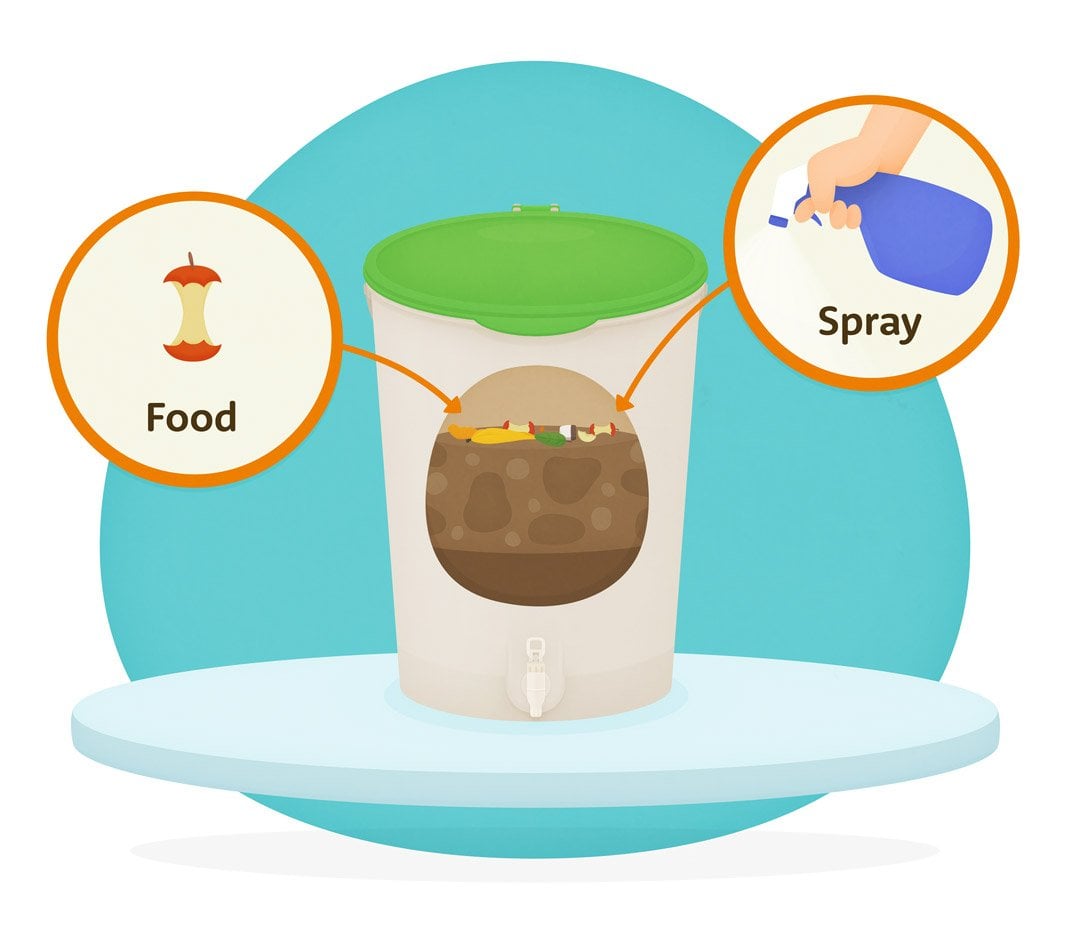Choose your tutorial
Composting and wormfarming are different ways of breaking down and recycling your food scraps into healthy soil. Depending on your household and garden situation, one will suit you best.

The different composting systems all accelerate nature's natural processes by heating up the compost and concentrating the microbes into a confined space.
Composting systems vary in what they recycle, including all types of organic waste such as food, paper, cardboard and garden materials. They all process larger volumes, making them suitable for households with a lot of food and/or garden waste.
Traditional (also known as above ground) compost bins need to be placed on soil. As the scraps break down, nutrient-rich liquid will disperse into the surrounding soil leaving rich compost to be harvested from the bottom every 6-12 months. They require regular (twice weekly) turning with an aerator.
Tumbling composters sit off the ground and can be placed anywhere, including balconies. The liquid from this process drips out and can be harvested or allowed to soak into the ground below. They require regular rotation with a hand crank or by rotating the drum directly, and produce rich compost in around 3-6 months (a little faster than traditional systems).
Solar composters are partially dug into the ground and capture more heat from the sun which aerates the compost without the need to turn it. So, they are faster than the other two systems and require less maintenance. They do not compost garden organics but do process all kinds of food waste and even pet poo!
Select tutorial

Works by accelerating nature’s natural process of breaking down organic waste into a rich nourishing compost, teeming with life and a supercharger for your garden.
Composting systems recycle all types of organic waste including food, paper, cardboard and garden materials. This makes them perfect for larger households.
Open-bottom units need to be placed on soil. As the scraps break down nutrient-rich liquid will disperse into the surrounding soil. After ~6 months compost can be harvested from the bottom.
Do the tutorial

Works by aerobic decomposition, using the sun’s energy to break down food scraps into nutrients that are dispersed by worms and leaching liquids, which nourishes the surrounding soil.
Zero waste. Zero maintenance. Solar boosted composter.
The Green Cone recycles all types of food waste (including meat, dairy, bread and small bones) as well as small amounts of pet poo (not recommended if it is installed near food crops!). Designed to naturally circulate oxygen, there is no need for regular aeration making it perfect for medium to large households looking for a low-maintenance solution.
The system needs to be buried in well-draining soil, with full sun exposure for most of the day. As the food scraps break down, nutrient-rich liquid will disperse into the surrounding soil. No harvestable compost is produced.
Do the tutorial

Works by accelerating nature’s natural process of breaking down organic waste into a rich nourishing compost, teeming with life and a supercharger for your garden.
Composting systems recycle all types of organic waste including food, paper, cardboard and garden materials. This makes them perfect for larger households.
Tumblers sit off the ground and can be placed anywhere, including balconies. As the scraps break down nutrient-rich liquid will drain from the tumbler and can be collected to fertilise your garden. After one chamber is full you can let the compost mature whilst filling the other. After ~6 months you can harvest the mature compost.
Do the tutorial

Works with the help of wriggly warriors who chew through your food scraps, producing nutrient-rich worm castings and liquid fertiliser.
Worm farms recycle fruit and vegetables scraps, excluding citrus, onion, garlic and chilli.
The units can be placed indoors or outdoors, in a sheltered location out of the wind, rain and direct sunlight.
With a little tender loving care, worms will chew through your food scraps to produce nutrient-rich worm castings which can be harvested every 2-6 months. Liquid fertiliser also flows out of the farm on a regular basis, which can be diluted 10 to 1 with water to create free organic fertiliser for your garden.
Choose from the Farm, our compact, stylish award-winning worm farm made here by the Compost Revolution in Melbourne, Australia, or the large capacity Hungry Bin, made in New Zealand and ready to much through 2L of good a day!
Do the tutorial

A special culture of beneficial, naturally occurring microorganisms (EM) ferment food waste in anaerobic conditions, producing liquid fertiliser and fermented scraps.
Bokashi systems ferment all types of food waste (including meat, dairy, bread and small bones). The unit can be placed indoors or outdoors, in a cool location.
Food waste is added then mashed down to remove air pockets, followed by a spray of enzyme or handful of enzyme grain. Effective microorganisms (EM) then ferment food waste in anaerobic conditions.
Liquid fertiliser needs to be tapped every few days. Once the unit is full, the scraps are left to ferment for 1-2 weeks before being added to a compost bin or buried in soil. Fermented scraps will break down in 2-3 weeks in the soil delivering rich nutrients to surrounding plants.
Do the tutorial
All Tutorials
Compost bins retain heat to speed up the process via above ground, partially buried, or rotating chambers.
- Processes lots of food scraps (limit meat and diary).
- Above ground and tumblers compost garden waste too.
- Low maintenance.
Produces rich harvestable compost for your garden and the sourrounding soil, plus tumblers produce liquid fertiliser.
See benefits
Hungry worms break down food scraps into solid and liquid nutrients in compact multi-tray and larger single tray farms.
- Processes medium amounts of food scraps, primarily fruit and vegetables.
- Suitable for indoor as well as outdoor placement.
- A bit more maintenance.
Produces rich harvestable worm castings as well as lots of liquid fertiliser for your garden.
See benefits
Bokashi uses anaerobic bacteria to ferment food waste into a readily decomposable ferment in a sealed kitchen bench bin.
- Ferments medium amounts of food scraps, all kinds!
- Suitable for kitchen or outdoor placement.
- Low maintenance, except when emptying.
Produces fermented food scraps (you then bury in soil) and lots of liquid for use as fertiliser for your garden, or a probiotic all purpose cleaner.
See benefits
Traditional compost bins accelerate nature's nutrient reycling using heat created within above ground chambers.
- Processes lots of food scraps (limit meat and dairy) and garden waste.
- Place above ground units on open soil.
- Low maintenance.
Produces rich compost for your garden.
See benefits
The Green Cone Solar Composter accelerates decomposition even faster than traditonal compost bins by harnessing the sun's power in twin chambers to produce heat and convective aeration.
- Processes lots of food scraps (inc. meat and dairy) + small amounts of pet poo!
- Must be dug into well draining soil in a sunny location.
- Almost zero maintenance.
Produces nutrients that enriches the surrounding soil (1m radius). Does not produce harvestable compost.
See benefits
Tumbler compost bins accelerate nature's nutrient reycling using heat created within rotating chambers.
- Processes lots of food scraps (limit meat and dairy) and garden waste.
- Tumblers can go anywhere including balconies.
- Low maintenance.
Produces rich compost and liquid fertiliser for your garden.
See benefits














